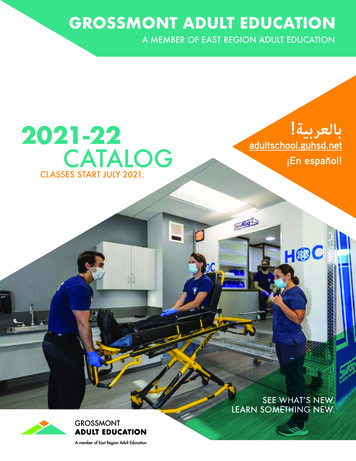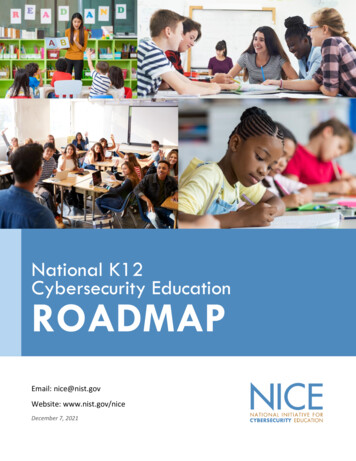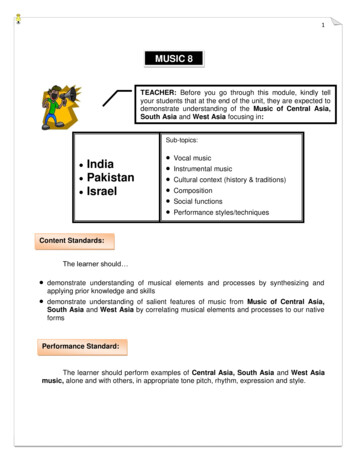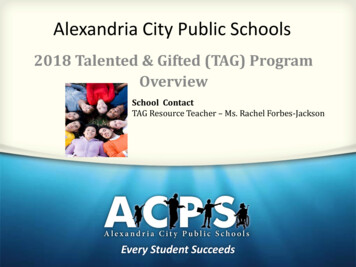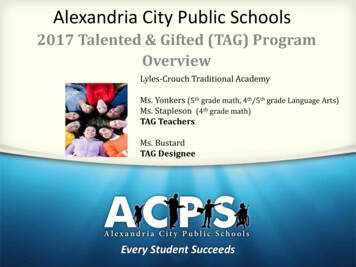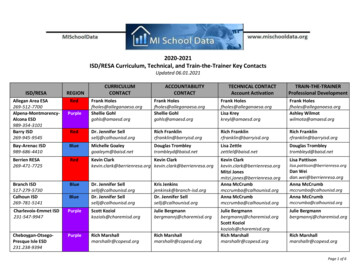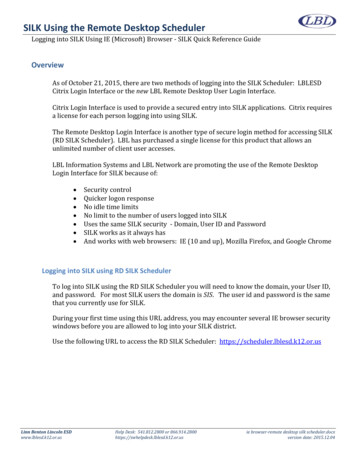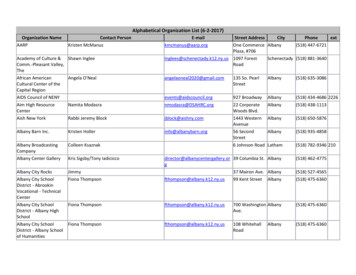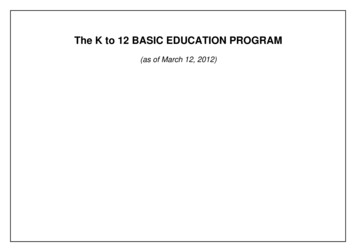
Transcription
The K to 12 BASIC EDUCATION PROGRAMThe K to 12 BASIC EDUCATION PROGRAM(as of March 12, 2012)i
The K to 12 BASIC EDUCATION PROGRAMTABLE OF CONTENTSElementary24PAGEI.II.The K to 12 Basic Education ProgramBackground and Rationale4Introduction4Historical Development of theBasic Education Program9Outcome Goals of the K to 12 BasicEducation Program10Process Goals of the K to 12Education Program10The K to 12 Basic Education Curriculum11Goal11The Learning Areas15Co-Curricular and CommunityInvolvement Programs15Core Content17Distinctive Features and Guiding Principles17Structure of the Curriculum23Kindergarten24Secondary24Alternative Learning System26III.The K to 12 Curriculum Guide30IV.Implementation Guidelines31V.Glossary of Terms32VI.References35VII.Committees on K to 12 Curriculum36
The K to 12 BASIC EDUCATION PROGRAMList of FiguresFIGUREList of TablesPAGETABLETable1Total Basic Education Cycle of AsianCountries7Table2Historical Bases of the Additional Years ofEducation, SEAMEO INNOTECH, 20117Table3Unemployment Rate in the Philippines,2010.8Table4Basic Education Curricular Reforms9Table5Common Competencies in the Grade 7 and8 TLE Exploratory Courses and Specializationin Grade 11 and 1228Figure1National Achievement Test Results SY 200520104Figure2Trends in International Mathematics andScience Study (TIMMS) 20035Figure3Average of TIMSS Scores, Philippines5Figure4Typical Progression of a Cohort of PupilsBased on a Cohort of Grade 1 Pupils from SY1995-1996 to College Graduates SY 20082009, both Public and Private6PAGEFigure5Unemployed vs. Available Skill-Based Jobs8Figure6The K to 12 Graduate12Figure7The K to 12 Philippine Basic EducationCurriculum Framework13Table6Proposed Subjects for Grades 11 and 1229Figure8The Learning Areas of the K to 12Curriculum16Table7The Components of the K to 12 Curriculumat a Glance30Figure9Structure of the K to 12 Curriculum23Figure10K to 12 Curriculum in both FormalEducation and Alternative Learning System26Figure11Core Learning Areas/Domains from K to 1227iii
The K to 12 BASIC EDUCATION PROGRAMThe K TO 12 BASIC EDUCATION PROGRAMI.BACKGROUNDand RATIONALEIntroductionThe K to 12 Basic Education Program is the flagship program of theDepartment of Education in its desire to offer a curriculum which isattuned to the 21st century. This is in pursuance of the reformthrusts of the Basic Education Sector Reform Agenda, a package ofpolicy reforms that seeks to systematically improve criticalregulatory, institutional, structural, financial, cultural, physical andinformational conditions affecting basic education provision, accessand delivery on the ground. The Department seeks to create abasic education sector that is capable of attaining the country’sEducation for All Objectives and the Millennium Development Goalsby the year 2015 and President Noynoy Aquino’s 10-point basiceducation agenda by 2016.These policy reforms are expected tointroduce critical changes necessary to further accelerate, broaden,deepen and sustain the Department’s effort in improving the qualityof basic education.Figure 1. National Achievement Test Results, SY 2005-2010The challenges of the Department are great but are notinsurmountable. Education outcomes in terms of achievement,participation and completion rates point to the urgent need toimprove the quality of basic education in the country. The NationalAchievement Test results for SY 2005-2010 show that manystudents who finished basic education do not possess sufficientmastery of basic competencies. (See Figure 1)Students’ performance in international tests such as theTrends inInternational Mathematics and Science Study (TIMSS) is as dismal.In Grade IV Math and Science, TIMSS, 2003, the Philippinesranked 23rd in performance out of 25 countries. For high schoolMath, the Philippines ranked 34thout of 38 countries. In high schoolScience, it ranked 43rd out of 46 participating countries.1 In TIMMS,2008 for Advanced Math, the Philippines ranked 10thout of 101National Center for Education Statistics. Highlights from the Trends in InternationalMathematics and Science Study 2003.December 20041
The K to 12 BASIC EDUCATION PROGRAMcountries, even with only theparticipating.2(See Figures 2 and 3)sciencehighschoolsFigure 3. Average of TIMSS Scores, PhilippinesAnother major challenge of the Department of Education is retainingthose in school, particularly those at risk of falling out of the system.Those who are at risk of dropping out are those who encounterdifficult circumstances in life – poverty, cases of teenagepregnancies, student laborers, children whose parents were poorlyschooled, slum dwellers, families who live in areas with peace andorder problems and learners with various forms of disabilities .Figure 2. Trends in International Mathematics and Science Study(TIMMS) 2003Figure 4 shows that of the 100 students who enrolled in Grade 1,only 65 students reached First Year high school and 46 of which2I.V.S. Mullis, M.O. Martin, D.F. Robitaille, & P. Foy, (2009). Chestnut Hill, MA. Trends inInternational Mathematics and Science Advanced 2008.2
The K to 12 BASIC EDUCATION PROGRAMgraduated HS. Of these 46 HS Graduates, only 20 reached collegelevel and 16 earned college degrees.congested, especially the Mathematics, Language and Sciencesubjects.The relatively weak performance of Filipino students in lippinesmustcatchupwiththereto the world.Besides, trade liberalization, the growing global market,international agreements such as the Bologna and WashingtonAccords have kept countries focused on the comparability ofeducational degrees. Filipino graduates need to develop acompetitive advantage over others in the ASEAN region and in theworld. Unfortunately, the ten-year basic education systemhandicaps overseas Filipino professionals competing in the worldmarket. The Bologna Process3 requires 12 years of education foruniversity admission and practice of profession in Europeancountries. On account of the Bologna Accord4, starting 2010,undergraduate degrees in the Philippines are no longer recognizedin most European countries. The Washington Accord5 prescribes aminimum of 12 years of basic education as an entry to recognitionof engineering professionals. Obviously, the short basic educationcycle is a deterrent in pursuing recent initiatives like the APEC andASEAN mutual recognition projects. APEC or Asia PacificEconomic Cooperation is an international forum of 21 membereconomies that acts collectively to advance their common interests.APEC is committed to a policy of reducing barriers to trade and ofFigure 4.Typical Progression of a Cohort of Pupils Based on aCohort of Grade 1 Pupils from SY 1995-1996 to College GraduatesSY 2008-2009, both Public and PrivateThe sad state of basic education in the country can be partlyattributed to the congested basic education curriculum. The basiceducation curriculum is meant to be taught in twelve years, yet it isdelivered in ten (10) years. The research findings of thecomparative study of the curricula of Brunei Darussalam, Malaysia,Singapore and Philippines conducted by SEAMEO-INNOTECH,affirmed that indeed the Philippine basic education curriculum is3Batomalaque, Antonio. Basic Science Development Program of the Philippines forInternational Cooperation. University of San Carlos.; Marinas, Bella and Ditapat, Maria.Philippines: Curriculum and Development. UNESCO International Bureau of Education4Batomalaque, Antonio. Basic Science Development Program of the Philippines forInternational Cooperation. University of San Carlos.; Marinas, Bella and Ditapat, Maria.Philippines: Curriculum and Development. UNESCO International Bureau of Education5International Engineering Alliance. The Washington Accord/FAQ.cfm (Accessed 11 September2010)3
The K to 12 BASIC EDUCATION PROGRAMIn 1949, the proposal to expand basic education was revived. 6Since then the call for extension of the Philippine basic educationduration persisted as presented in Table 2.being a vehicle for promoting economic cooperation within the AsiaPacific Region. (Source: SEAMEO INNOTECH Study)The Philippines is the last country in Asia and one of only threecountries in the world (the other two being Djibouti and Angola ofAfrica) with a ten-year pre-university program. (Refer to Table 1).CountryTotal BasicEducation CycleTotal Duration ofPre- UniversityEducationBruneiCambodiaIndonesiaLao 14/15121012/14121214/15YearSource: SEAMEO-INNOTECH, 2011Table 1. Total Basic Education Cycle of Asian CountriesSourceRecommendation1949UNESCO MissionSurveyRestore Grade VII in primary education1953Education ActRevise the Primary school system by adding one year(Grade VII)1960Swanson SurveyRestore grade 7 in Primary education1970PCSPE1991EDCOM Report1998PhilippinesEducation SectorStudy (World Bankand ADB)2000PCER2006Philippine EFA 2015National Action Plan2008Presidential TaskForce on EducationExtend secondary education by one year to better preparestudents who have no plans to take up university educationRetain the 10-year basic education phase whileinstitutionalizing career counseling in Primary andsecondary schools in preparation for higher educationPrioritize student learning through curricular reforms, theprovision of textbooks, the use of the vernacular in lowerPrimary grades, and the institution of a longer basiceducation cycleImplement a compulsory one-year pre-baccalaureate stageas prerequisite for students interested in enrolling in highereducation degree programsLengthen the educational cycle by adding two years toformal basic education (one each for Primary and highschool)Extend pre-university education to a total of 12 years,benchmarking the content of the eleventh and twelfth yearswith international programsCompuloryTable 2. Historical Bases of the AdditionalYears of Education,LearningSEAMEO INNOTECH,2011AreasUntil the 1930s, the Philippines actually had 11 years of basiceducation: seven years of primary and four years of secondaryschooling. The Commonwealth government even then, did not feelthat 11 years provided adequate preparation for tertiary educationor the work place. It decided to reduce the primary cycle to sixyears, which was duly done, and added two years to high school,which did not happen. (de Jesus, Edilberto. Philippine DailyInquirer, 01/08/2010).sted in enrolling in higher education degree programsThe poor2006quality of basic education as reflected in the inadequatepreparation of high school graduates for the world of workcontributestoEFAthe20 relatively high unemployment rate among thePhilippinecareer paths/ choicesyoung andtheeducated.See Table 3.Exploratory Courses4for Academic Specialization Journalism Mother Tongue6 & Foreign LanguagesEstherCare and Ethel Valenzuela, Analysis of Basic Education of theVI.Technical- Vocational LanguagesPhilippines:Implicationsfor the K to 12 Education Program, Jan. 2012.VII.Math for SpecificPurposes Life Sciences/Physical Sciences Literature Contemporary Issues(local and global) Career Pathways- Entrepreneurship-Tech Voc- Academic
The K to 12 BASIC EDUCATION PROGRAMTable 3 shows that of the 80.6% unemployed by age group, 51.5%are 15-24 years old and below. The 70.9% unemployed wentthrough school from high school to college. The Table shows thatthe largest percentage of unemployed is the group of high schoolgraduates, 33.1%. Figure 5also shows that there is huge number ofskills-based jobs available (650,000 ) and also a huge number ofunemployed high school graduates (972458). This implies amismatch between graduates’ skills and job demands.Figure 5. Unemployed vs. Available Skill-Based Jobs(Source: NSO, 2009 and 2010)Table 3. Unemployment Rate in the Philippines, 2010.5
The K to 12 BASIC EDUCATION PROGRAMHistorical Development of the Basic Education ProgramLike the K to 12 curriculum, the curricular revisions were backed upby research findings and recommendations. The issue of curriculumcongestion which resulted to the learners’ lack of mastery of basiccompetencies was the reason behind the introduction of thedecongested New Elementary Education Curriculum (NESC) andNew Secondary Education Curriculum (NSEC) in 1983 and 1989,respectively and the 2002 Basic Education Curriculum. Forrelevance, the 2-2 plan was introduced for the secondary schools in1958 which was revised in the offering of electives for secondarystudents in 1973, to give students choice on career path.The historical development of the Philippine basic educationprogram proves the Department’s continuing effort at improving thequality and relevance of basic education. In terms of curriculumdevelopment, Table 47shows that since 1945, the elementarycurriculum underwent three (3) revisions while that of the secondarycurriculum underwent four (4) before the K to 12 curriculums. Thisis because the introduction of the 2-2 Plan, 2-year collegepreparatory and 2-year vocational curriculum, was relevant only tothe secondary.In the 2-2 Plan, both general and vocational secondary schoolsoffered the basic or common curriculum of academic courses withone unit of Practical Arts in the first two years. In the last two years,the general secondary schools offered a pre-college academiccurriculum with one unit of vocational elective each year while thevocational secondary schools offered more specialized vocationalcourses with one unit of academic elective each year. 8The 2-2 Plan was a differentiated curriculum leading either to acollege or a technical course. Similar to that of the K to 12curriculum, one of the guiding principles of the 2-2 Plan was that―the curriculum of each school should provide vocational courseswhich are geared to the occupations, resources and industries ofthe community or region where the school is located.‖9 It was seento be a very responsive curriculum, however, it was met withstrong opposition especially from the private sector whichrequested for its deferment due to lack of money, facilities,equipmentfor vocational education and lack of guidancecounselors10. The pitfalls of the 2-2 Plan implementation could beattributed to ―insufficient preparation before the plan wasTable 4. Basic Education Curricular Reforms8Board of National Education, General Policies on Education, 1967-1972,Board of National Education, General Education Policies : A Report , 1959-196110Board of National Education, General Education Policies : A Report , 1959-196179Prepared by Avelina T. Llagas , former Director of the Bureau of Secondary Education,DepEd6
The K to 12 BASIC EDUCATION PROGRAMimplemented and the continued high ’prestige’ value of the collegepreparatory course in the eyes of parents and students.11―backward design‖ which necessitates determining targets andgoals and assessment first beforei dentifying and planning learningactivities to ensure clarity of targets.To respond to the need on improving curriculum relevance toincreasing diverse contexts of learners as a result of globalizationand in addition to the issue of an overcrowded curriculum thathaunted basic education, the Department of Education restructuredthe NESC (1983) and the NSEC (1989) into the 2002 BasicEducation Curriculum (BEC).The issue on lack of mastery of concepts and skills partly due to acongested curriculum did not end even with the riculum decongestion. Thus the K to 12Basic Education Program is notonly concerned with curriculum decongestion but also with othercritical concerns like addressing shortages of educational inputs ,improving the quality of teachers and strengthened stakeholders’participation.The 2002 BEC, the forerunner of the K to 12 curriculum, is adecongested curriculum consisting of five (5) core learning areasfrom as many as ten (10).It had the following objectives: Connect related subjectsIncrease the time allotted for Science, English, andMathematics;Reduce congestion of subjects;Improve attitude towards work to increase productivity ;Increase individual's ability to cope in a fast changingworld;Increase the importance of the arts, music, sports,dance, and other aspects of Philippine culture; andDevelop nationalism among Filipino learners forresponsible citizenryThe K to 12 Basic Education Program is a comprehensive programin the sense that the support systems to ensure its implementation the family and other stakeholders, instructional, administrative andsociety as a whole are given the needed attention.After the introduction of the 2002 BEC, the Bureau of ElementaryEducation conducted a thorough review of the competencies toenhance the vertical articulation of competencies. In 2010, theBureau of Secondary Education implemented the 2002 BEC basedon UbD design for meaningful and integrative teaching. This wascalled 2010 SEC. This curriculum design is focused on teaching forunderstanding and on essential and big ideas. It makes use of the11Board of National Education, General Education Policies : A Report , 1959-19617
The K to 12 BASIC EDUCATION PROGRAMOutcome Goals of the K to 12 Basic Education Program7. Institute reform in assessment framework and practicefor a learner-centered basic education8. Address basic input shortages in classrooms, teachers,textbooks9. Promote good education governance in the entireDepartment of EducationThe K to 12 Basic Education Program seeks to realize the following:1. Philippine education standards to be at parwithinternational standards2. more emotionally mature graduates equipped withtechnical and/ or vocational skills who are betterprepared for work, middle level skills development andhigher education3. significantly addressed shortages or gaps in educationalinputs (teacher items, school head items, classrooms,instructional materials) addressed significantly4. broadened and strengthened stakeholders’ support inthe improvement of basic education outcomes5. improved internal efficiency6. improved system of governance in the Department7. improved quality of teachers10. Pursue legislation to institutionalize K to 12 BasicEducation Program11. Formulate transition management plan for the K to 12implementation by including modeling per region perspecialization12. Identify K to 12 model schools per region and perspecialization tracks that will model senior high schoolby SY 2012-2013.Process Goals of the K to 12 Basic Education Program1. Decongest and reform the basic education curriculum incoordination with CHED, TESDA and other educationstakeholders2. Develop culture-sensitive, culture-responsive anddevelopmentally appropriate print/non-print onlinelearning resources for K to 123. Conduct in-service training for teachers relative to theimplementation of the K to 12 curriculum4. Focus on integrated instruction to equip learners withskills for future employment , critical and creativethinking and life skills5. Universalize kindergarten by 20126. Institutionalize school-based management for schoolempowerment8
The K to 12 BASIC EDUCATION PROGRAMII.THE K TO 12 BASIC EDUCATION CURRICULUMGoalAs Figure 6 shows, the K to 12 Basic Education Curriculum isgeared towards the development of a holistically developedFilipino with 21stcentury skills who is ready for employment,entrepreneurship, middle level skills development and highereducation upon graduation from Grade 12.9
The K to 12 BASIC EDUCATION PROGRAMFigure 6. The K to 12 Graduate10
The K to 12 BASIC EDUCATION PROGRAMof the K to 12 Curriculum is achieved when every K to 12 graduatedemonstrates the desired outcomes as illustrated below:The K to 12 graduate is equipped with the following 21st centuryskills: 1) information, media and technology skills, 2) learningand innovation skills, 3) effective communication skills, 3)effective communication skills and 4) life and career skills.Information, media and technology skills include 1) visual andinformation literacies, media literacy, basic, scientific, economic andtechnological literacies and multicultural literacy and globalawareness. The learning and innovation skills are 1) creativityand curiosity; 2) critical thinking problem solving skills and risktaking. To develop effective communication skills, the followingskills must be taught: 1) teaming, collaboration and interpersonalskills; 2) personal, social and civic responsibility and interactivecommunication, and local, national and global orientedness. Thelife and career skills are: 1) flexibility and adaptability; 2) initiativeand self-direction; 3) social and cross-cultural skills; 4) productivityand accountability, 5) leadership and responsibility, and 6) ethical,moral and spiritual values.The ideal K to 12 graduate is one who manifests patriotism andnationalism, love of humanity, respect for human rights,appreciation of the role of national heroes in the historicaldevelopment of the country, observance of rights and duties ofcitizenship, strong ethical and spiritual values, moral character andpersonal discipline, critical and creative thinking, scientific andtechnological knowledge, and vocational efficiency‖12.The ideal K to 12 graduate is one who has discovered his/herpotential in a child-centered and value-driven teaching-learningenvironment, one who is enabled to create his/her own destiny in aglobal community, one who is prepared to become a who loveshis/her country and is proud to be a Filipino.13The overarching goal1213Philippine Constitution, Article XIV, Section 3. (2)DepEd’s vision statement, http://www.deped.gov.ph11
The K to 12 BASIC EDUCATION PROGRAMFigure 7. The K to 12 Philippine Basic Education Curriculum Framework12
The K to 12 BASIC EDUCATION PROGRAMcurricular programs in a large sense also serve as a laboratory oflife where what is learned in the classroom context can be appliedin practical terms yet be used as a further teachable opportunity.Co-curricular and community involvement programs areirreplaceable opportunities for the learner to reinforce and put intopractice the knowledge, skills, values and attitudes learned.The Learning AreasThe cluster of subjects of the K to 12 curriculum- Languages, Mathand Science, Arts and Humanities, and Technology and LivelihoodEducation – cuts across the grade levels from K to Grade 12 tonurture the learner’s holistic development. There is no demarcationline among the cluster of subjects- to indicate that the curriculum isorganized to cut across subject lines and to put across the conceptthat the whole curriculum is life itself.Co-curricular programs and community involvement programs arean extension of the core subject areas and the teaching andlearning process. They are an integral part of the school curriculumthat enhances the holistic development of the learner. The cocurricular programs in a large sense also serve as a laboratory oflife where what is learned in the classroom context can be appliedin practical terms yet be used as a further teachable opportunity.Co-curricular and community involvement programs areirreplaceable opportunities for the learner to reinforce and put intopractice the knowledge, skills, values and attitudes learned.The Language subjects are Mother Tongue, Filipino and English.The Arts and Humanities subjects are Edukasyon saPagpapakatao, Araling Panlipunan, Music, Arts, Physical Educationand Health (MAPEH). The other subjects are Science, Math andTechnology and Livelihood Education.There are changes in the nomenclature of some subjects.Edukasyonsa Pagpapahalaga for the secondary and Edukasyon saPagpapakatao for the elementary are now renamed Edukasyon saPagpapakatao. Science and Health is called Science. Health isjoined to MAPEH.The learning areas in the K to 12 curriculum can be groupedinto two: 1) core compulsory learning areas and 2) areas ofspecialization. These are enumerated in the discussion ofelementary and secondary education.Co-Curricular and Community Involvement ProgramsCo-curricular programs and community involvement programs arean extension of the core subject areas and the teaching andlearning process. They are an integral part of the school curriculumthat enhances the holistic development of the learner. The co-13
The K to 12 BASIC EDUCATION PROGRAMFigure 8. The Learning Areas of the K to 12 Curriculum INFORMATION, MEDIA, AND TECHNOLOGY SKILLS LEARNING INNOVATION SKILLS General Academic ProgramNONE Mother TongueFilipino English MathematicsScienceAraling PanlipunanEdukasyon saPagpapakataoMAPEHNONEDevelopment of knowledge, skills,attitude and values: mastery andapplication basic skills EnglishFilipinoMathematicsScienceAraling PanlipunanMAPEHEdukasyon sa PagpapakataoEPPTLE Exploratory Courses SubjectsLEARNING DOMAIN Values Education Physical Health &MotorDevelopment Social &EmotionalDevelopment CognitiveDevelopment Creative Arts LanguageLiteracyCommunication English Filipino Mathematics Science Music, Arts, PE & Health(MAPEH ) Araling Panlipunan Edukasyon sa Pagpapakatao Technology & LivelihoodEducationSpecializationin TLENONEDevelopment and masteryof complex knowledge andskills, developmentof attitudes and values. In Grade 1, oral Filipino is taught in 1st Semester and oral English in the Second SemesterConsolidation of complexknowledge and skills,development of attitudes, values,aptitudes and interest. For Grades 7 and 8 only LIFE AND CAREER SKILLS EFFECTIVE COMMUNICATION SKILLS 14 Languageso -Englisho -Filipino Literature Mathematics Science ContemporaryIssues AcademicSpecializationo Mathematicso Scienceo Languageso Journalismo Sports and Arts Technical- Vocational OthersConsolidation of complexknowledge and skills,development of attitudes,values as a result of astrong liberal education;adequate preparation for theworld of workentrepreneurship, middlelevel skills development andhigher education.
The K to 12 BASIC EDUCATION PROGRAM3. It is developmentally appropriate. –The K to 12 curriculumconsiders the various developmental stages of learners. Selectionof activities is informed by age-appropriateness, individualdifferences, and social and cultural diversity.Distinctive Features and Guiding Principles1. It is learner-centered.–The learner is the very reason of theentire curriculum system. Who the learner is in his/her totality, howhe/she learns and develops and what his/her needs are were highlyconsidered in the making of the K to 12 curriculum framework.4. It is standard-based and competency-based.–What learnersshould know and be able to do and the levels of proficiency atwhich they are expected to demonstrate what they know and cando are clearly stated in the form of standards unpacked intocompetencies. With a standards- and competencies-basedcurriculum, learners understand what are expected of them, parentsare clear on what are expected of their children, teachers areguided on what to teach and how to teach, and the DepEd isprovided with a common reference tool for national assessment.The holistic learning and development of the learner is its primaryfocus. Teacher creates a conducive atmosphere where the learnerenjoys learning, takes part in meaningful learning experiences andexperiences success because he/she is respected, accepted andfeels safe even if in his/her learning exploration he/she commitsmistakes. He/she learns at his/her own pace in his/her own learningstyle. He/she is empowered to make choices and to becomeresponsible for his/her own learning in the classroom and for alifetime.With standards, competencies are connected to ensure integratedand meaningful teaching instead of isolated, disconnected andmeaningless teaching.The learner-centered K to 12 curriculum gives prime importance todeveloping self-propelling and independent lifelong learners.5. It is research-based. –The new features of the K to 12curriculum are backed up by hard data. The use of Mother Tongueas a medium of instruction from K to Grade3is supported by aresearch finding that children learn better and are more active inclass and learn a second language even faster when they are firsttaught in a language they understand.2. It is inclusive.–The vision statement of DepEd states ―Weaffirm the right of every Filipino child especially the less advantagedto benefit from such system.‖14 (referring to the existing educationalsystem.) It reaches out to all kinds of learners regardless of ability,condition, age, gender, ethnicity, and social status. It is built on theprinciple that every child has a right to education and that theeducation system needs to be flexible to accommodate the learningneeds of all learners. The emphasis is on making schools learnerfriendly, mainstreaming learners with disability into general schools,and creating a non-discriminatory education system where alllearners have equal opportunity to learn.14The strengthening of ICT-integration in the basic educationcurriculum in order to meet the 21st century skills required byemployers, the use of the spiral progression approach in theteaching of Math and Science and the development of alternativedelivery modes to provide equal opportunity for all are backed up bythe recommendations of the DEpED-commissioned researchesconducted by SEAMEO-INNOTECH and University of Melbourne.DepEd’s vision statement, http://www.deped.gov.ph15
The K to 12 BASIC EDUCATION PROGRAMOther research recommendations that were integrated in the K to12 curriculum are the use of the expanding spiral progressionapproach in the teaching of Science, Mathematics, AralingPanlipunan, MAPEH and Edukasyon sa Pagpapakatao and thedeliberate teaching of the investigatory process in Science as aseparate topic by Grade 7.8. It is culture-responsive and culture-sensitive.-To be trulyinclusive, the K to 12 curriculum respects cultures and experiencesof various ethnic groups and uses these as resources for teachi
Mar 12, 2012 · Science Study (TIMMS) 2003 5 Figure 3 Average of TIMSS Scores, Philippines 5 . Figure 7 The K to 12 Philippine Basic Education Curriculum Framework 13 Figure 8 The Learning Areas of the K to 12 Curriculum 16 Figure 9 Structure of the K to 12 Curr
